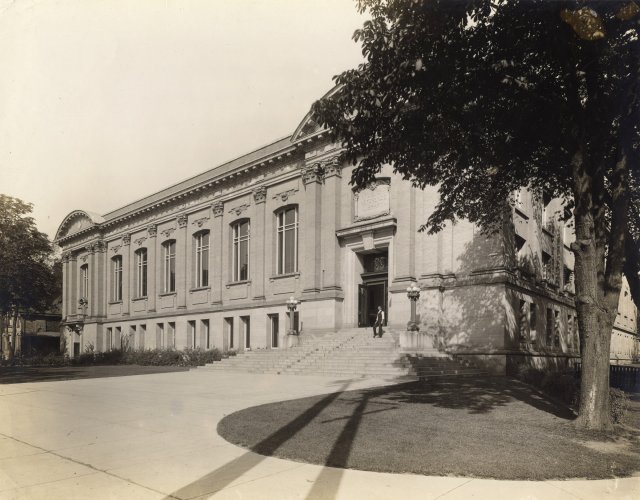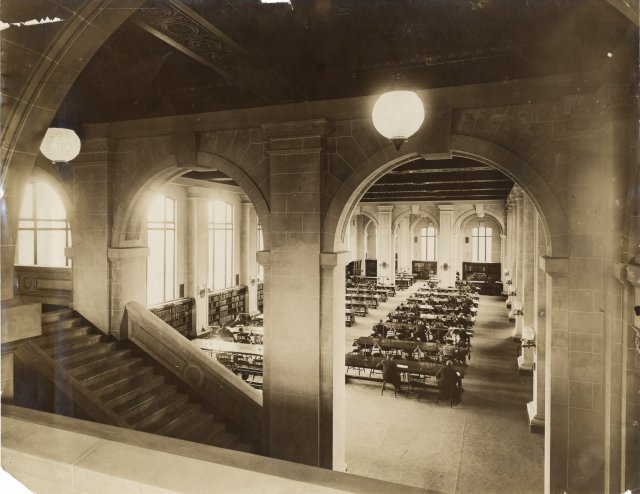Of the
111 libraries funded by Andrew Carnegie in Ontario, none was larger (or more expensive) than Toronto’s first purpose-built central reference library at the corner of St. George and College. When it was first established in 1884, the central reference library’s collection was housed in the old Mechanic’s Institute at Adelaide and Church Street. Unfortunately this original space was cramped, cold and leaky – precarious conditions for Toronto’s most important public library collection. Andrew Carnegie’s gift at the beginning of the 20th century allowed Toronto to build a library fitting of this growing institution.
The design for this important civic building was determined through an architectural competition. In October 1905 a call for plans went out including detailed specifications and a prize of $750 to be divided between the first three selections. 19 plans were submitted by the January 31, 1906 deadline. A jury - composed of the Mayor, a city councillor, a public library trustee, the chief librarian, the City Architect and one non-competing architect - reviewed all 19 submissions and declared that no entry had met the requirements. Four competitors whose submissions were judged to be satisfactory were then invited to modify their schemes and resubmit. The four firms were Wickson & Gregg and A.H. Chapman, Associated Architects (Toronto); Gordon & Helliwell (Toronto); J.A. McKenzie (Toronto); and William Newlands, from Kingston.
On May 12, 1906 the scheme by Wickson & Gregg and A.H. Chapman, Associated Architects was announced as the winner. Chapman, Wickson and Gregg would all play important roles in the design of many of Ontario’s Carnegie libraries. Chapman had previously apprenticed with architect Beaumont Jarvis of Toronto, who had designed the Carnegie libraries in Orangeville (1904) and Lucknow (1905). He would later design the Carnegie libraries in Dundas (1904) and Barrie (1914). Wickson & Gregg would design the Brampton library (1906).

Exterior of the library, 1914, Courtesy of Toronto Public Library
As with many civic buildings of the era, the winning scheme is strongly Neoclassical, exhibiting a clearly defined hierarchy of spaces, classical detailing, and subtle polychromy – all reflective of Chapman’s architectural training at the École de Beaux Arts in Paris. The main façade is highly symmetrical, with flanking entrances on either ends of the building. The ground floor, clad in smooth grey stone, is punctuated by rectangular paired windows. Above them, six softly arched windows, separated by brick pilasters with composite capitals, indicate the location of the main reading room. Yellow brick and grey stone define the library’s exterior material palette. The main entrance to the reference library, at the east end of the building, is highlighted by grand exterior steps, while a more discrete ground level door marks the entrance to the branch library on the west end.
 Reading Room as seen from Mezannine, 1909, Courtesy of Toronto Public Library
Reading Room as seen from Mezannine, 1909, Courtesy of Toronto Public LibraryThe interior was as elegantly laid out as the exterior, and no space was grander than the great reading room. Occupying most of main floor, the reading room was a double-storey space bathed in southern daylight. Beautiful stone finishes and a highly ornate ceiling provided plenty of atmosphere and inspiration to library users.
 Reference Reading Room, 1920, Courtesy of Toronto Public Library
Reference Reading Room, 1920, Courtesy of Toronto Public LibraryThe new Central Reference Library finally opened its doors in 1909. By 1929, Chapman was asked to extend the building northward, something that he had already considered in his initial 1906 plan.
After 60 years of service, the decision was made to build a new library to consolidate the ever increasing collection. In 1977, the Toronto Reference Library moved to its current home designed by Raymond Moriyama Architects at Yonge and Asquith, just north of Bloor. After some renovations and additions, the former library was given new life as the University of Toronto’s Koffler Student Service Centre and the UofT Bookstore. Fittingly, the renovations were done under the supervision of architect Howard Chapman, son of Alfred Chapman.
Want to learn more about the current home of the Toronto Reference Library? Then click here for our blOAAg post Toronto Reference Library (1977). Sources Beckman, Margaret, Stephen Langmead, and John B. Black. 1984.
The best gift: a record of the Carnegie libraries in Ontario. Toronto: Dundurn Press.
Osbaldeston, Mark. 2011.
Unbuilt Toronto 2: more of the city that might have been. Toronto: Dundurn Press.
Toronto Public Library, http://www.torontopubliclibrary.ca/about-the-library/library-history/carnegie-central-reference.jsp